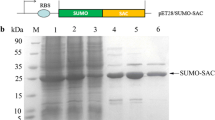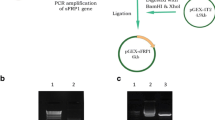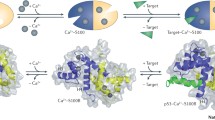Abstract
To explore the biological roles of human Pescadillo and investigate its potential effect on tumorigenesis, the cDNA of Pescadillo was fused with that of GST. After purification and elution, the purified GST-Pescadillo fusion protein was obtained, and the antibody against the fusion protein was generated. Endogenous Pescadillo protein was observed to be remarkably induced by estrogen. It was mainly distributed in the tissues such as breast, ovary and intestine, all of which contain proliferating cells, and was also detected in many cell lines of human cancer: renal carcinoma, hepatoma, ovarian cancer, colon carcinoma, and breast cancer. The expression level of Pescadillo was increased significantly in breast cancer tissues compared with their paired margin tissues. Taken together, these data suggest that Pescadillo may play important roles in the initiation and development of cancer and may be a potential target in cancer diagnosis and therapy.
Similar content being viewed by others
References
Allende M L, Amsterdam A, Becker T, et al. Insertional mutagenesis in zebrafish identifies two novel genes, pescadillo and dead eye, essential for embryonic development. Genes Dev, 1996, 10(24): 3141–3155
Maiorana A, Tu X, Cheng G, et al. Role of pescadillo in the transformation and immortalization of mammalian cells. Oncogene, 2004, 23(42): 7116–7124
Monteiro A N, August A, Hanafusa H. Evidence for a transcriptional activation function of BRCA1 C-terminal region. Proc Natl Acad Sci USA, 1996, 93(24): 13595–13599
Callebaut I, Mornon J P. From BRCA1 to RAP1: A widespread BRCT module closely associated with DNA repair. FEBS Lett, 1997, 400(1): 25–30
Gowen L C, Avrutskaya A V, Latour A M, et al. BRCA1 required for transcription-coupled repair of oxidative DNA damage. Science, 1998, 281(5379): 1009–1012
Bork P, Hofmann K, Bucher P A. Superfamily of conserved domains in DNA damage-responsive cell cycle checkpoint proteins. FASEB J, 1997, 11(1): 68–76
Zhang H, Fang Y, Huang C F, et al. Human Pescadiollo induces large-scale chromatin unfolding. Sci China C-Life Sci, 2005, 48(3): 270–276
Charpentier A H, Bednarek A K, Daniel R L, et al. Effects of estrogen on global gene expression: Identification of novel targets of estrogen action. Cancer Res, 2000, 60(21): 5977–5983
Kinoshita Y, Jarell A D, Flaman J M, et al. Pescadillo, a novel cell cycle regulatory protein abnormally expressed in malignant cells. J Biol Chem, 2001, 276(9): 6656–6665
Liu Y F, Ding L H, Hao C F, et al. Expression and purification of XBP-1 fusion protein and preparation of polyclonal antibody against protein. Lett Biotechn, 2004, 20(6): 762–767
Zhao X R, Wang C X, Luo F J, et al. The Epstein-Barr virus encoded latent membrane protein 1(EBV-LMP1) activates expression of Cyclin D1. Prog Biochem Biophy, 2001, 28(5): 704–710
Haque J, Boger S, Li J, et al. The murine Pes1 gene encodes a nuclear protein containing a BRCT domain. Genomics, 2000, 70(2): 201–210
Lerch-Gaggl A, Haque J, Li J, et al. Pescadillo is essential for nucleolar assembly, ribosome biogenesis, and mammalian cell proliferation. J Biol Chem, 2002, 277(47): 45347–45355
Prisco M, Maiorana A, Guerzoni C et al. Role of pescadillo and upstream binding factor in the proliferation and differentiation of murine myeloid cells. Mol Cell Biol, 2004, 24(12): 5421–5433
Metivier R, Penot G, Hubner M R, et al. Estrogen receptor-alpha directs ordered, cyclical, and combinatorial recruitment of cofactors on a natural target promoter. Cell, 2003, 115(6): 751–763
Pearce S T, Jordan V C. The biological role of estrogen receptors alpha and beta in cancer. Crit Rev Oncol Hematol, 2004, 50(1): 3–22
Nilsson S, Makela S, Treuter E, et al. Mechanisms of estrogen action. Physiol Rev, 2001, 81(4): 1535–1565
Author information
Authors and Affiliations
Corresponding authors
Additional information
Supported by the National Natural Science Foundation of China (Grant Nos. 30500191, 30530320, 30470378, and 30625035)
Rights and permissions
About this article
Cite this article
Zhang, H., Li, J., Wang, X. et al. The antibody preparation and expression of human Pescadillo. SCI CHINA SER C 50, 298–304 (2007). https://doi.org/10.1007/s11427-007-0045-x
Received:
Accepted:
Issue Date:
DOI: https://doi.org/10.1007/s11427-007-0045-x




